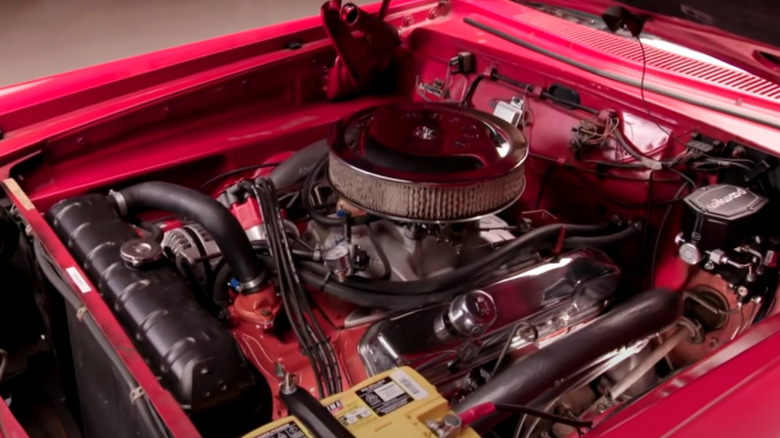What Is A Mopar Max Wedge Engine, And How Did They Get Their Name?
The Mopar name — a portmanteau of "motor" and "parts" — was coined by Chrysler in the late 1930s to brand its new antifreeze along with other parts and accessories and has since become an umbrella term for all of the auto labels that have come under the Chrysler banner. Mopars were a force in the muscle car era of the 1960s and early '70s, thanks in large part to their array of beastly V8 engines. While most gearheads are familiar with the iconic hemi, the RB series of big-block V8s that bridged the gap between the first two generations of hemi are just as impressive.
The baddest of the RB-series V8s was the Max Wedge, a high-performance variant that first appeared in 1962 with a displacement of 413 cubic inches and an output of 420 horsepower in high-compression form. That number was possible largely thanks to the twin four-barrel carburetors and ram air intake. The 'wedge' half of the name came from the shape of the engine's combustion chambers, which were tapered to concentrate power on the top of the pistons. The 'max' designation indicated the presence of upgrades over the standard RB series like larger ports and valves with beefed-up springs and a high-lift cam to take advantage of the improved valvetrain.
The second-gen Hemi replaced the Max Wedge
Atop the 413 cubic inch Mopar Max Wedge engine sat a special intake manifold with those two Carter 650 cubic foot per minute carburetors, and inside were forged connecting rods and pistons to deliver the extra power to the crankshaft. In Plymouth models, the Max Wedge carried the Super Stock designation, and Max Wedge Dodges were labeled as Ramchargers. The Plymouth Belvedere, Savoy, Dodge 330, and Dart could all be ordered with the Max Wedge starting in 1962, and a 426 cubic inch Max Wedge was made available in 1963.
In 1964, the Max Wedge was also available in the Dodge Polara, which Jay Leno called "a great looking car" on an episode of his show, "Jay Leno's Garage." He was the third owner of his '64 Max Wedge Polara 500 and speculated that the original owner only drove the dragstrip-ready car "a quarter mile at a time."
Chrysler then turned its engine development efforts to building a new Hemi engine for NASCAR racing, and by 1966, a street version of the 426 Hemi had supplanted the Max Wedge.
